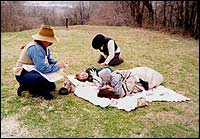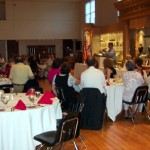Saluda Memorial, Lexington, Missouri (2002, 2004)

On April 9, 2002, a memorial was presented to the city of Lexington, Missouri commemorating the sesquicentennial of the Saluda steamboat tragedy. Many people were killed, including 28 Latter-day Saint emigrants who were traveling west on the Missouri River headed towards the Salt Lake Valley.
A large group that included descendants of the passengers of the Saluda gathered for the ceremony. Michael L. Hutchings, of the Foundation, and Thomas Brailsford, who represented The Church of Jesus Christ of Latter-day Saints, offered their thanks to the city in remembering the victims of the tragedy.
Mormon Historic Sites Foundation provided a contribution to create a beautiful plaque listing the names of all known victims.

The memorial was erected in a small park specificially donated for the commemoration and is located on the northwest corner of 13th and Franklin Avenues in Lexington. The park is also home to a bell from the same era as the Saluda. During the ceremony, several descendants of Saluda victims took turns ringing the bell in remembrance of their ancestors.
Abraham Smoot, a Mormon emigrant leader who was an eye-witness of the Saluda tragedy spoke of the people of Lexington when he said, “I shall never forget the kindness of the citizens of Lexington in caring for the living and burying the dead… prominent citizens did all they could to comfort and help the afflicted survivors.”

On Friday, June 11th, 2004, Fred E. Woods, executive director of the Foundation and Church History professor, and L. Douglas Smoot, BYU Dean emeritus, Engineering and Technology, and former Area Seventy addressed a group of 150 people at the Liberty Jail. The group was comprised of members of The Church of Jesus Christ of Latter-day Saints, the Community of Christ, and other denominations that joined to hear the inspiring story of the Steamboat Saluda.
Smoot, great-grandson of Abraham O. Smoot, who was appointed to oversee the victims of the tragedy, expressed gratitude to the citizens of Lexington for their compassion shown at the time of the historic event.
Professor Woods emphasized the message that we learn from the Saluda echoes the ideas that “in the essentials let there be unity, in the non-essentials, liberty, and in all things charity.”
Fred E. Woods, L. Douglas Smoot, and Michael L. Hutchings spoke to the citizens of Lexington at the Wentworth Military Academy in Lexington, Missouri. Smoot thanked the local citizens assembled for their care of the Saints when this tragedy arose in April 9, 1852.
Professor Woods gave a commentary of the documentary “Fire and Redemption: The Explosion of the Steambot Saluda.” He also performed a song on a guitar he borrowed from the Pastor Aubrey Burke, of the First Baptist Church in Lexington, dedicated to the charitable folk of Lexington entitled “Have You Heard of the Saluda?”
Finally, Michael L. Hutchings, secretary and trustee for MHSF spoke about the gratitude he felt and thanked the Lexington local citizens for taking care of his great-great grandmother, Matilda Weisman, who was to be married the morning of the disaster of the Saluda. Michael also presented Roger Slusher, director of the Lexington Museum, with a DVD copy of “Fire and Redemption: The Explosion of the Steamboat Saluda.”
Roger expressed his feelings about the event by stating the following in an email dated June 16, 2004 to Fred E. Woods, “Since Sunday I have heard one enthusiastic compliment after another about the film, the comments by you, Doug, and Mike.”
Photos
Articles & Resources
Fire & Redemption
Learn how the people of Lexington, Mo., came to the aid of Mormon pioneers when the pioneers suffered disaster due to the explosion of the steamboat Saluda.
Gratitude Goes on for 1852 Kindnesses
Author(s): Unknown
Published in: Church News
Publication Date: June 26, 2004

LEXINGTON, Mo. — When an 1852 steamboat explosion on the Mississippi River near this city killed 75 passengers, including some two dozen Mormon immigrants en route to Salt Lake City, the townspeople opened their hearts and homes to the wounded and survivors.
Now 152 years after the tragedy, a video documentary chronicling the incident has been presented to the Lexington Historical Association, according to Jolene Clark, Kansas City Missouri Stake public affairs media specialist. Also, young women from the Olathe Kansas Stake have given service in honor of the kindness of the Lexington residents in 1853.
The explosion of the steamboat Saluda and the humanitarian efforts of townspeople were memorialized two years ago on the 150th anniversary of the incident with an observance, monument unveiling and dedication of a memorial park involving Latter-day Saint descendants of the victims. A month later, a book by two BYU Church history professors, William G. Hartley and Fred E. Woods, was published about the incident. (See March 16, 2002, Church News, p. 14.)
On June 13 of this year, a DVD copy of the documentary, “Fire and Redemption: The Explosion of the Steamboat Saluda,” was presented to the historical association. The premiere showing of the film took place at a dinner reception hosted by the association that was followed by commentary from experts.
Brother Woods, who is featured in the documentary along with Brother Hartley, briefly described the turbulent history of the Church that led to the expulsion of Church members from Missouri in 1838. Fourteen years later, the explosion of the steamboat occasioned the beginning of a healing process, as the citizens of Lexington rescued the wounded, buried the dead, found homes for the orphans and raised money to help others continue their journey. Later in the evening, Brother Woods played the guitar and sang the words to an original song, “Have You Heard of the Saluda?”
L. Douglas Smoot, a descendant of Abraham Smoot, who was the leader for the Church members on board, shared some excerpts from the personal papers of his ancestor. After witnessing the tragedy, Abraham Smoot wrote: “I shall never forget the kindness of the citizens of Lexington in caring for the living and burying their dead. . . . Prominent citizens did all they could to comfort and help the afflicted survivors.”
Michael L. Hutchings, a member of the Mormon Historic Sites Foundation, which presented the documentary copy to the historical society, told of his ancestor Matilda Wiseman, who survived the explosion. She was dressed in her wedding gown and was to be married that day aboard the Saluda to John Sargent. He was killed, and the citizens nursed her back to health before she continued her journey to Utah.
Visitors to a museum in Lexington will be able to view the documentary, which features many local residents.
This month, young women and their leaders from the Olathe Kansas Stake journeyed on six homemade boats down the Mississippi. During their first stop, they performed service in Lexington, said Colleen Drake, public affairs specialist. They donated books, DVDs and videotapes to the Trails Regional Library in honor of the compassion shown to the survivors. Following the dedication of a solid granite park bench to the Saluda memorial, they divided into three groups: one provided a story time about the Saluda at the library; another did much-needed planting at the park; and a third planted flowers and erected a fence at the burial site of the victims.
Abraham O. Smoot and the Saluda Steamboat Explosion, 9 April 1852
Author(s): L. Douglas Smoot
Published in: Mormon Historical Studies
Publication Date: Spring 2004
“Don’t Go Aboard the Saluda!”: William Dunbar, LDS Emigrants, and Disaster on the Missouri
Author(s): William G. Hartley
Published in: Mormon Historical Studies
Publication Date: Spring 2003
Letter of appreciation from the Mayor of Lexington
Dedication of Saluda Memorial in Lexington, Missouri
Author(s): Fred E. Woods
Published in: Site & Scene
Publication Date: Fall 2002
 Site and Scene – Volume 4, Number 1 – Fall 2002
Site and Scene – Volume 4, Number 1 – Fall 2002

On April 12, 2002, the Lexington News reported: “the Lexington Historical Association held a crowded dedication ceremony at a memorial for victims of the Saluda explosion April 9. A large group that included descendants of the passengers of the Saluda gathered at the site . . . Michael Hutchings, of the Mormon Historic Sites Foundation, and Thomas Brailsford who represents regional Church of Jesus Christ of Latter-day Saints congregations, offered their appreciation to the city for its efforts to remember the victims. Mayor Tom Hayes presented copies of a proclamation honoring the sesquicentennial of the tragedy.”
This Saluda sesquicentennial commemoration was the highlight of the Lexington Steamboat Days which were held April 6-9. On the final day of Lexington’s festivities, the commemoration recalled the tragic event of the explosion of the steamboat Saluda in which many were killed, including 26 Latter-day Saint emigrants who were traveling west on the Missouri River, bound for the Salt Lake Valley. The Mormon Historic Sites Foundation provided a generous contribution to create a beautiful plaque listing the names of all known victims. It was erected at a quaint little park specifically donated for the commemoration, located on the northwest corner of 13th and Franklin Avenues. This historic site is also home to a bell which is from the same era as the bell which was blown from the Saluda. During the ceremony, several descendants of Saluda victims each took turns ringing the bell in remembrance of their lost loved ones.

This eventful commemoration was echoed through radio programs, Missouri newspapers, and was even reported nationally by the Associated Press. Each report seemed to herald the kindness extended to the victims and their families by the efforts of the benevolent Missouri citizens of Lexington. Abraham Smoot, a Mormon emigrant leader who was an eye-witness of the Saluda tragedy recalled, “I shall never forget the kindness of the citizens of Lexington in caring for the living and burying the dead . . . prominent citizens did all they could to comfort and help the afflicted survivors.” An extension of this same kindness was demonstrated by present citizens of Lexington who wanted to pay respect to the descendants of the Saluda victims. A sweet mutual affection between them and the families of the victims prevailed throughout the festivities. BYU professors, William G. Hartley and Fred E. Woods wrote a book for the occasion titled, Explosion of the Steamboat Saluda (Salt Lake City: Millennial Press), which they dedicated to the people of Lexington.
This moving story will be told on KBYU-TV this coming fall in a historical documentary which is currently being produced by Professor Woods.
Town memorializing 1852 steamboat disaster
Author(s): R. Scott Lloyd
Published in: Church News
Publication Date: March 16, 2002





